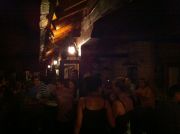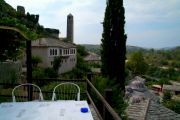The medieval village of Počitelj, remaining on UNESCO's tentative list of World Heritage Sites, boasts extensive ruins of magnificent fortress dating back to the 15th century and an intriguing mosque built a century later, badly damaged in 1993.
|
 |
 |
 |
 |
 |
 |
 |
 |
View of the village from just above the car park.
 |
 |
Počitelj was one of the clearest examples of how much unnecessary damage and destruction the Balkan War of the 1990s had caused to the region. And how much of this destruction was still visible so much, so very sadly. For only five years ago, the village's 550 years old mosque was still toppled, and many grand houses were ruined beyond repair. When I visited, positive signs o reconstruction and repair indicated a move in the right direction. Yet, much remained to be done. Perhaps one day, Herzegovina will look as pretty as it had looked before this mindless and uncivilised war, fueled by blind hatred, fanatic extremism, raw racism and an absolute lack of tolerance and acceptance.
Back to the trip... I found Počitelj on UNESCO's World Heritage Tentative List. This was how it ended on my itinerary. It was relatively easy to get to, as it lay on the main road between Mostar and Dubrovnik. To be honest, I was not sure if it deserved an accolade as a World Heritage Site, yet again UNESCO had listed less spectacular spots (eg León Viejo, Nicaragua) but some incredible places have not been listed (eg San Sebastian del Oeste, Mexico). Its main qualities either bad been and subsequently restored or remained badly ruined when I visited. And a few similar spots not only in the region but across Europe and Middle East existed. And it would need to be unique and original to be inscribed.
Počitelj was small. Three hours at relaxed pace would cover everything, including climbing both ends of the ruins, taking pictures, relaxing on a couple of terraces and enjoying he views, and inspecting the great mosque and a couple of significant houses.
|
|
| Favourite spots: |
 |
 |
 |
 |
 |
 |
 |
 |
The tower of the fortress.
 |
 |
On the steps leading to the fort's main tower, there was a section, which offered great views of the entire village. It was superb. I do not think photographs could capture it adequately. Plus there were the butterflies, bees, wasps and other bugs flying around, which added to the ambience, which could not be captured. While climbing, I did have to remember to turn back and stop to examine the scenery. Often, one has to be careful when a path is steep or tricky and forgets to check the scenery behind. And often that scenery is a photographer's dream come true.
|
|
| What's really great: |
 |
 |
 |
 |
 |
 |
 |
 |
The rooftop in the village, typical for a public bath and a mosque.
 |
 |
I took a stroll around this little place, even getting lost a little. I climbed on the ruins of the 15th century fort and its northern tower. I thought that I could take a good photograph from one of the tower's windows (holes for windows), but I was not sure how far to climb the narrow stairs. The ruins were completely wild, which had an advantage of being completely free to visit, and a disadvantage of being completely unprepared for visitors. So, if one fell inside the tower's narrow winding stone stairs and broke something and lay there then only the next adventurous tourist would find them. And who knows how long that would be. I also wanted to climb the southern ramparts, but I could not find the way. I kept ending outside the walls rather than within them, on the towers and former royal quarters.
|
|
| Sights: |
 |
 |
 |
 |
 |
 |
 |
 |
Hajji Alija Mosque, restored to its former beauty.
 |
 |
The Hajji Alija Mosque (built in 1563, destroyed in August 1993, reconstructed in 2005) was one of the prominent sights in the village. Its ornament carved on the stone base of the minaret was its special feature. The mosque had excellent acoustics. In 1952, its longitudinal portico of the mosque was removed in the modernist approach to strip additions to styles that did not 'belong' to the mosques.
The fort & tower of Počitelj was built in 1471 by the Hungary kings, including Matthias Corvinus and then Hamzabeg. Until the early 18th century, the fort was commanded by a dizdar and then by a captain, until about 1835. The fort had a secret gateway to provide a way out in an event of siege. After the Austro-Hungarian occupation, much of the ramparts were demolished.
The Gavrankapetanovic House, one of a few interesting houses in Počitelj. It was built at the turn of the 17th century for the captains of Počitelj, who came from the Gavrankapetanovic family. This house was the largest.
|
|
| Accommodations: |
 |
 |
 |
 |
 |
 |
 |
 |
Twin room number 103 at hotel Kriva Ćuprjia II
 |
 |
I spotted only one sign in the town saying 'apartmani', meaning rooms and flats for rent. When I investigated online before departing from home, I could not find anything of a hotel kind in Počitelj and only one drab looking hotel in Čapljina, about 3 kilometres away. So, when I arrived in Mostar, 35 kilometres from Počitelj, and confirmed that accommodation would be hard to find, I extended my stay in Mostar for an extra night.
I stayed at the Kriva Ćuprjia II Hotel, 3 minutes walk from the old bridge in Mostar. I booked it through booking.com, and was charged €32 for the single use of a twin room. I got room #103 on arrival. It was modern, very clean and had a great bedding. There was a small TV set hanging from the wall, a desk and a chair and a night stand between the two single beds. The en suite bathroom had a sophisticated shower cabin, complete with 'rain' head, regular shower head with a few settings and a back massage nozzles.
|
|
| Nightlife: |
 |
 |
 |
 |
 |
 |
 |
 |
Night at Caffe Eldino in Mostar.
 |
 |
There was nothing in terms of nightlife in Počitelj. Options were to travel either to Čapljina or Mostar for some night action. There were a couple, literally, of cafes in Počitelj and they did not look anything like converting into clubs at all. Of course I cannot know fir sure, as I did not stay in the village long enough to check. Mostar, however had a number of good and very good places to party at night or socialises with the locks over a drink. One of the extremely live spots was Caffe Eldino, which attracted mainly teenagers sipping BAM3 (€1.50) bottles of local lager and jumping to the local rhythms. A nice pub, looking very civilised and for grownups was the Marshall Cafe, based in an old house with cool interior.
|
|
| Hangouts: |
 |
 |
 |
 |
 |
 |
 |
 |
The Muta Mustafa Alagić Terrace
 |
 |
Muta Mustafa Alagić Terrace, above restaurant and cafe called Muta was one of the best places to sit down, relax and sip a negate while admiring the panorama of this magical little place. The tables were simple, and at least half of them were shaded for the entire time, different tables at different times of the day were caught by the sun rays. A good thing for those looking for some warmth or wanting to improve their colour. I noticed that locals liked the terrace, too. I spotted a few elderly ladies catching up on their gossip over there while enjoying their coffee. They spoke loudly and confidently, and one of them seemed a little sad about something. This country had some much suffering, including self-inflicted, and there were still many reasons to be sad, when I visited.
|
|
| Restaurants: |
|
The Caffe Bar Stari Grad was one of few places set up for visitors in terms of catering. Počitelj was such a small place that the tourism facilities were very basic. This meant the Stari Grad cafe did not suffer from the lack of customers, as there was hardly anywhere else to go for a meal. The Muta Mustafa Alagić Terrace might have had also offered meals, although I was not sure about that. I did not eat at the Stari Grad, but it had a regular quick fix dishes, which I could spot on people's plates.
|
|
| Other recommendations: |
 |
 |
 |
 |
 |
 |
 |
 |
The view of the village and the walls.
 |
 |
Coaches on the way from Mostar (and Sarajevo) to Dubrovnik (and Čapljina) passed via Počitelj. It was an easy trip to make, as the village was only about 35 kilometres from Mostar. However, it was not easy to make the return journey. One would have to walk to Čapljina (3 kilometres away) and then catch a coach bound north. It was possible to hitch, but that would need to in love talking to tourist visiting the place and asking them for a ride. Alternatively, a taxi could be arranged in Mostar. Drivers would ask about €25 for the return trip including waiting time of up to 2.5 hours, but alternative arrangements, based on a specific pick up time for the return ride were also available for a little extra. Any hotel in Mostar and a tour agent would oblige to contact a taxi driver and participate in the negotiations.
|
|
Published on Sunday September 19th, 2010
|
|
 Publish on Facebook
Publish on Facebook
|
Sun, Oct 10 2010 - 03:30 AM
 by basia
| All of your reports always read with pleasure. Thank you. |
| Information: |
| Login if you are a member, or sign up for a free membership to rate this report and to earn globo points! |
|
| Bulgaria |
|
|
 |
| Burkina Faso |
|
|
|
|
 |
| Cambodia |
|
|
|
|
 |
| Cameroon |
|
|
|
|
 |
| Canada |
|
|
 |
| Cape Verde |
|
|
 |
| Chile |
|
|
 |
| China |
|
|
|
|
|
|
|
|
|
|
|

|
